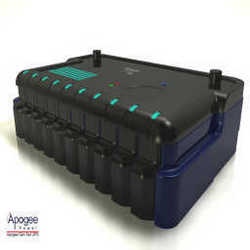Dear sir ,
Chanced to browse your website and must say intrigued by the efforts this organisation is making in finding solutions to some of the vexing problems ,
Recently happened to read some of the work done by ” Green Mobile Services ” a London based organization who in association with “International Funding corporation” has done some good studies , Particularly Uganda in association with MTN, Haiti In association with Digi cell etc In all these cases it appears that reduction of Diesel consumption for powering telecom towers to power te BTS has been attempted
In all these cases the batteries used for back up power has been the VRLA ( valve regulated lead acid Batteries)
VRLA batteries have inherent disadvantages/ limitation
require reconditioning of the battery room thus consuming power for air conditioning provided by the DG set ( batteries do not power theA/c)
requires regular Maintenance adding to the man power requirement
capacity decreases as the room temperature goes up
Foot prints are higher
suffers from sudden death ( a common and inherent problem with lead acid batteries)
Ampere hour efficiency is low and watt hour efficiency is rather lower and so on
In the recent Months these have been astounding developments in regard to the ” Lithium ” Batteries , more so after the “OBAMA” President of USA advanced Huge grants for the development of batteries for “Electric Vehicle”. Safety issues which were once a concern have been dealt with and t o day it is not such a serious issue .
The attachment details the several advantages of Lithium over the conventional VRLA batteries , and would consider it a privilege to receive your views and feedback
Thanking you with best regards
G.Raghavan
Bangalore
Mob 91-0-9980512439
A VRLA battery (valve-regulated lead-acid battery) vs Lithium
|
Sl no
|
Attributes
|
VRLA
|
Lithium
|
Remarks
|
|
1
|
Electrode Chemistry
|
Acid
|
Alkaline
|
|
|
2
|
Individual cell voltage
|
2.00
|
3.7o
|
Higher cell voltage
|
|
3
|
No of cells required for 48 v system
|
24 cells
|
13 cells
|
Lower no of cells
|
|
4
|
Current cell capacity
|
Generally 600 ah
|
Much lower
|
To be decided/sized
|
|
5
|
Approx Dimensions of cells LxWxHt
|
300x175x350mm
Tol +/-2mm
|
Much lower less than 60 % of VRLA
|
Lower size
|
|
6
|
Approx weight of cell in Kgs
|
~40 Kgs
|
Significantly lower say 55%
|
Less weight better for support structures
|
|
7
|
Approx foot prints of 48 v system LxWxHt
|
1300x375x1300
|
Significantly lower
|
Saving of space
|
|
8
|
Wt of battery bank
|
~1050 Kgs
|
<500 Kgs
|
Lower weight
|
|
9
|
Float voltage/cell
|
2.25
|
4.2v
|
|
|
10
|
Charging current
|
~12-15% of rated ah ,72-90Amps
|
1 C is Fine no harm preferred is 0.3C
|
Lower charging time
|
|
11
|
Time taken to fully charge
|
10-12 Hrs
|
2-3 Hrs only
|
Saving in time
|
|
12
|
AH efficiency
|
~90 %
|
Better than 98%
|
Saving in power loss , reduction in opex
|
|
13
|
Watt hr efficiency
|
~70%
|
>93%
|
Power saving
|
|
14
|
Operating Temperature
|
Prefer 22-28deg C
|
Safe up to 55degC
|
No A/C required saving in cooling power requirement
|
|
15
|
Maintenance
|
Required
|
Not required
|
Saving in Man hours
|
|
16
|
Individual cell protection
|
Does not exist
|
Individually cell protection provided
|
Safe and reliable
|
|
17
|
Over charge issues
|
Detrimental
|
cut off provided
|
Safe
|
|
18
|
No of cycles @80%DOD
|
~1200cycles
|
>3000 cycles
|
Longer life
|
|
19
|
No of cycles @50%DOD
|
~1600
|
>5000cycles
|
As above
|
|
20
|
Hydrogen liberation during operation
|
Yes liberated
|
None
|
Safer
|
|
21
|
Sudden deaths
|
Possible
|
None
|
Reliability enhanced
|
|
22
|
Self Discharge
|
High
|
Very low
|
Hardly any longer storage period
|
|
23
|
Sulphation issues
|
Applicable
|
None
|
|
|
24
|
Capex
|
Low
|
Higher
|
Initially
|
|
25
|
Opex
|
High
|
Very low
|
Savings
|
|
26
|
Cost per cycle
|
High
|
Very low
|
Lower total cost
|
|
27
|
Operation efficiency of SMPS rectifiers
|
Low since they operate at lower levels
|
High since they can operate/charge at higher currents
|
Savings in Opex estimated at 14 %
|
|
28
|
Savings On A/c of no Air conditioners
|
None
|
Huge
|
Lower rated power requirements
|
|
29
|
Derating of cell capacity due to orientation
|
Yes applicable between vertical and horizontal positioning
|
None
|
|
|
30
|
Life expectancy
|
3-4 years Max
|
10 years minimum
|
Huge savings
|










